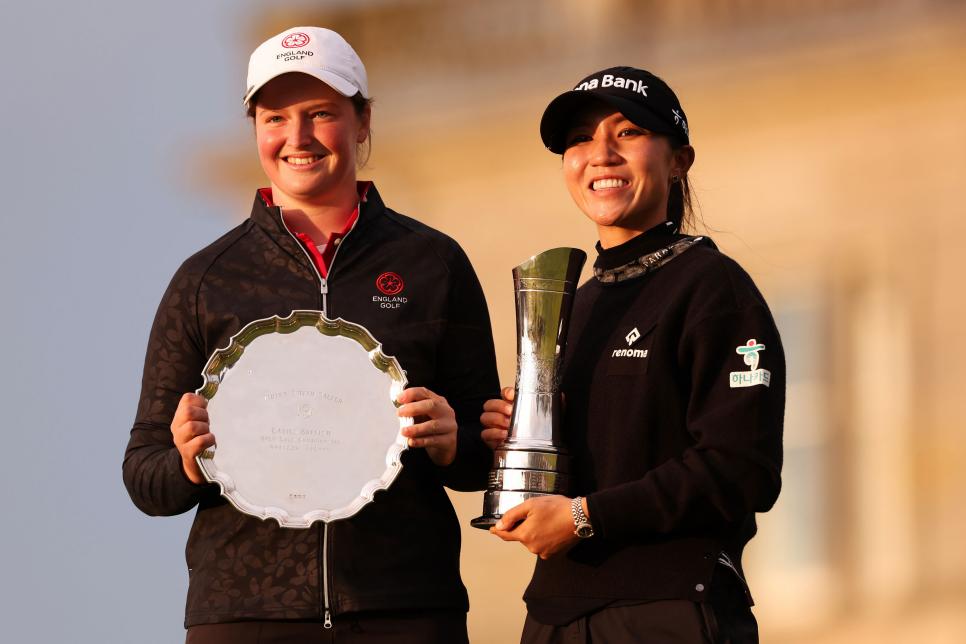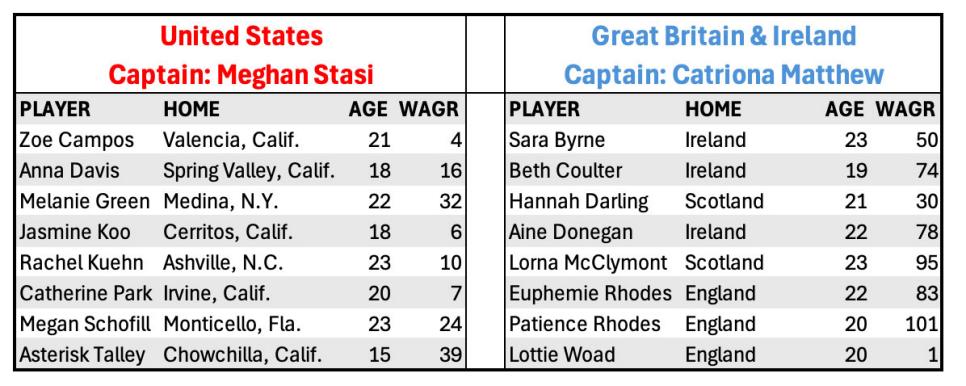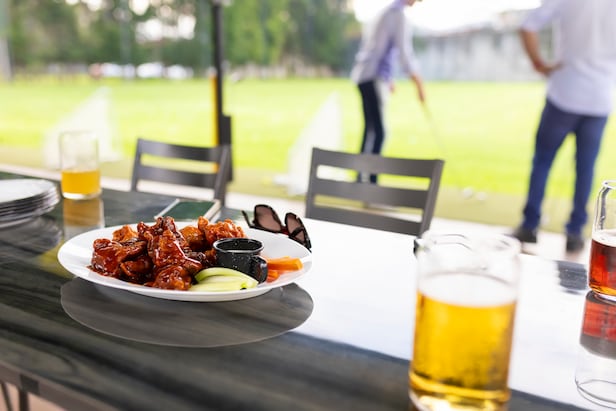Zip lines, axe throwing and confidence boosting: Catriona Matthew is all in for her Curtis Cup captain debut – Australian Golf Digest

- by Admin
- August 27, 2024

The same, but different. That is pretty much how Catriona Matthew—“Beany” to her friends—compares her latest role of Great Britain & Ireland Curtis Cup skipper with her pair of Solheim Cup-winning European captaincies. The first professional to take on the position in the biennial matches between the best amateur female golfers from GB&I and the United States, Matthew is aiming for what would be a notable hat-trick of victories over American teams either side of the am/pro divide.
It is an enticing prospect, but also one that has presented the just-turned 55-year-old Scot, who played in three Curtis Cups in the early 1990s, with a new set of challenges. While the experience gained in those Solheim Cups will surely come in handy when the matches get under way this week at Sunningdale Golf Club, dealing with less familiar names and faces has led to the former Women’s Open champion approaching this captaincy from a new direction.
“The biggest difference for me was simply getting to know the players,” Matthew says. “In the Solheim, I was familiar with every one of the players. I’d played alongside them all and had knowledge of their games and temperaments. And I knew them off the course, too. That’s also an important part of captaincy. This time the main challenge for me was getting as close as possible to that level of intimacy. Just as important, of course, was the players getting to know me. They are used to captains they know well and have spent a lot of time around. So this has been a learning experience for them, too.”
Matthew, who led Europe to victory twice in the Solheim Cup, is bringing years of experience in team events with her as she becomes the first professional to captain a Curtis Cup team.
David Cannon
As part of that process, the eight-strong squad joined Matthew and assistant Kathryn Imrie (U.S.-based Karen Stupples, a Women’s Open champion at Sunningdale, is the other assistant) for a “bonding weekend” at Sunningdale earlier this month.
“I wanted the players to feel comfortable around me,” Matthew says. “And I think we achieved that. I spoke to them, impressing on them that I have been in their shoes and I know it isn’t easy. I know they are going to be nervous. The last thing I wanted was for them to think I’m standing there judging them. That was another big adjustment I had to make from when I was Solheim captain.
“We played four-ball matches, something the players don’t have much experience of,” she continues. “They play more foursomes. So we worked a little on what to do in certain situations. For example, if one player has a short putt for par and the other a long putt for birdie, who goes first? I wanted them thinking about that stuff. Nothing is ever black-and-white, the length of the short putt and the difficulty of the long putt need to be assessed every time.”
More From Golf Digest  curtis. cup U.S. Curtis Cup team practices at Pine Valley before heading to matches in England
curtis. cup U.S. Curtis Cup team practices at Pine Valley before heading to matches in England  Curtis Cup The Americans are on a Curtis Cup roll. Here’s the 2024 roster that hopes to keep the momentum
Curtis Cup The Americans are on a Curtis Cup roll. Here’s the 2024 roster that hopes to keep the momentum
That day spent on the course was predictably invaluable, especially the advice offered by long-time Sunningdale member and former European Ryder Cup captain, Sam Torrance. But perhaps just as crucial was the time spent at the nearby “GoApe” adventure playground, advertised as “adventures that will help you bond with your family and friends by uniting you in a shared challenging experience, filled with fun and excitement.”
More specifically, some of the activities on offer are “racing down zip lines, aiming for the Axe Throwing bullseye, or seeing who can bounce the highest on ‘nets adventure.’”
Details as to which of the GB&I players flourished most in that environment are sketchy. Suffice to say, as Imrie does, “that it all contributed to a great weekend.”
“Our aim was to have the players be relaxed,” says Imrie, 57, the first Scot to win on the LPGA Tour. “And I think we succeeded in that. Maybe the best aspect of it all was I could see the respect every player has for Beany. That was cool to see. They will play hard for her, no question. They will be highly motivated to do well for her, for the team and for themselves.”

The U.S. Curtis Cup team has more players in the top 50 of the World Amateur Golf Ranking than GB&I, but the home side has World No. 1 Lottie Woad, who finished T-10 (low amateur) at last week’s AIG Women’s Open.
Morgan Harlow/R&A
If past history is a guide, beating the Americans is going to be a long way from straightforward for the GB&I players to achieve. Despite owning home advantage in the shape of the historic Old Course at Sunningdale, they will enter the contest in their familiar role of heavy underdogs. While there have been occasional signs of competitive life in a contest that dates back to 1932, the U.S. has an overall record of 31-8-3, including victories in each of the last three encounters. It is no exaggeration to say that anything other than a win for a stacked U.S. side (the lowest-ranked American, 15-year-old Asterisk Talley, is ranked above six members of the GB&I squad) would be a surprise of sizeable proportions.
But not impossible. For one thing, Matthew has up her sleeve what might be defined as something of a “Seve factor” in the shape of the World No. 1 Lottie Woad, winner of the Augusta National Women’s Amateur in April and fresh off a T-10 finish to earn low amateur honors at the AIG Women’s Open at St. Andrews. Just as the late, great Spaniard showed fellow Europeans like Nick Faldo, Ian Woosnam, Sandy Lyle, Bernhard Langer and Jose Maria Olazabal that it was possible to go to the States and win majors, Matthew sees Woad’s presence providing similar inspiration.
“Statistically, Lottie is the best player on the planet,” says Matthew, whose side contains only one player, fellow-Scot Hannah Darling, with past Curtis Cup experience. “So the other players have seen what can be achieved. She definitely gives them more confidence. They have all played with her and they know that, on a given day, they can beat her. So, while they might be lower ranked than the opposition, they know we have the best player on our side. That’s huge. And a message I’ve tried to impress on all of them. My view is that one-on-one our players are just as good as the Americans.”
Fighting talk. The key, however, will be how they get on “eight on eight.”
Meet the Curtis Cup teams 
This article was originally published on golfdigest.com
The Latest News
-
January 9, 2025Australian captain Pat Cummins in doubt for Champions Trophy as ankle injury revealed
-
January 9, 2025Alex de Minaur faces prickly path as Nick Kyrgios lands ‘kind’ Australian Open draw
-
January 9, 2025Missing Australian hiker found after surviving two weeks on muesli bars and berries
-
January 9, 2025De Minaur handed tricky Aus Open draw, Jones to face former Wimbledon champ
-
January 9, 2025Captain Cummins in doubt for Champions Trophy | cricket.com.au





